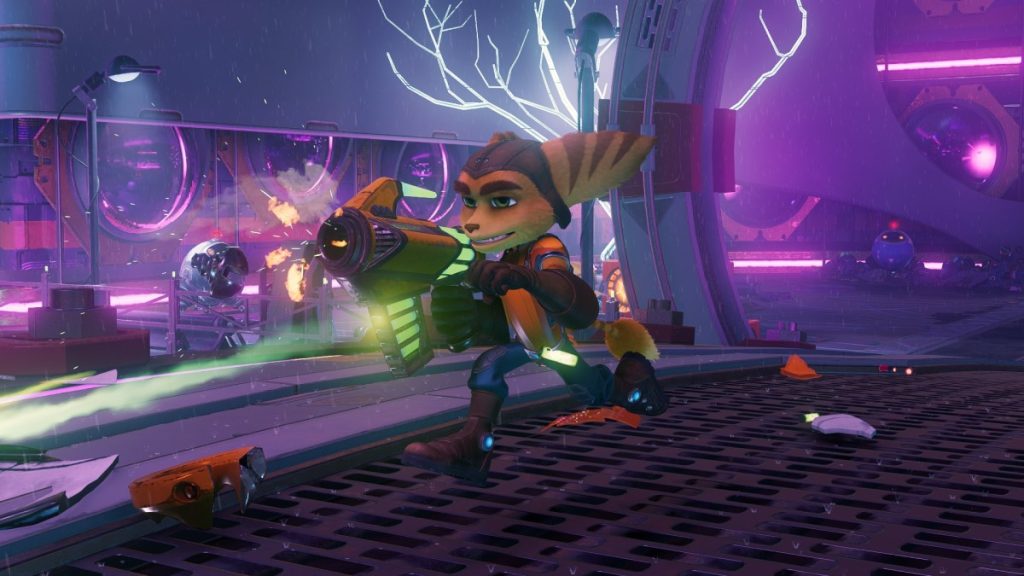Ratchet & Clank: Rift Apart (PC) – Review – PSX Brasil
Ratchet and Clank is one of the most classic, enduring and, to some extent, famous PlayStation franchises. With the games starting there around the time of the last PS2, the adventures of lombax and his robot best friend never really grabbed me – in fact, I only had some contact with the franchise through the remake/reboot (released in 2016) of the first game. The game had its charms, but at the same time nothing there grabbed me to the point of piqued my curiosity compared to the other titles in the series.
It wasn’t until 2021, with Rift Apart on PlayStation 5, that I gave the franchise another chance to convince me of what I was missing. Introducing new characters, mechanics, and acting as a showcase of sorts for what the PS5 was capable of, this game is a treat. Even adopting a more professional style and cartoonish visual style, the graphics are hauntingly beautiful, the controls are responsive and the gameplay itself is simply bom
But the technical part was what caught my attention the most. On the PlayStation 5, Insomniac Games is known for doing absurdities and true wonders when it comes to the technical side of their games. One of the easiest examples I can give is how well Marvel’s Spider-Man runs on console, relying on different graphics modes – including one with high frame rates and ray tracing enabled.
In Ratchet and Clank: Rift Apart it would be no different. Experiencing the game on a huge TV in 120 fps mode is one of the best choices one can make with this privilege. Soon, with the announcement that the game would be coming to PC, curiosity to see how a game that was so hyped for the PS5’s SSD would work on an open platform was high, to say the least.
When you start the game, you can see that the entire set of settings that Nixxes (the studio responsible for the PC port) brought to Marvel’s Spider-Man and Miles Morales are also here, with various possibilities for customization and greater control of how the game will run and appear. Ray tracing, image reconstruction technologies and other niceties are present.
Before I comment on my experience with the game, it’s worth remembering: These are my general impressions, I just played the game and tested some graphics and performance options. I only have my personal machine to play with, so all I’ll comment on here is my experience with it.
First impressions were positive and pretty much what I expected from a Nixxes port. Good image quality at my monitor’s native resolution and performance hovered between 70-50 fps with everything on high, DLSS quality mode and ray tracing active with all effects also on high.
Performance occasionally dropped depending on the size of the action and particles on screen, repeatedly dropping to 40fps. In the second world, Sargasso, the large amount of foliage, shadows and effects took a heavy toll on the graphics card, which struggled to break through the 50-40 fps margin. I had to make some adjustments to the image quality, mainly in the ray tracing – as the ray tracing in relation to the shadows had some graphical errors (a similar problem happened with Marvel’s Spider-Man: Miles Morales).
That said, we need to talk about the elephant in the room: is an SSD required to play Ratchet and Clank: Rift Apart on PC? In summary, yes, using a high-speed storage device becomes a necessity for good game fluidity, especially during times when there are many world transitions in a short period of time.
Digital Foundry, a YouTube channel that analyzes technical games for consoles and PC, performed an extensive series of tests with various storages, including NVME 4th generation, sata SSDs and even old HDs (including what was on the original PS4 model, with only 5400 RPM of speed). The results are very interesting and expected: high-performance NVME had the result more similar to that of PS5, while the sata SSD showed some stuttering to load the levels while the HD took seconds to load, almost breaking the game.
In my computer I have a 1TB 3rd generation NVME SSD from Crucial. This SSD has a read speed of around 1.9GB/s, which is pretty decent for a device of this generation. While playing, I did experience small and slight stuttering when scene transitions happened too quickly, but not enough to spoil my immersion or even consider it a problem.
Overall, I found the port to be very stable, even if some minor graphical issues (like ray tracing in shadows) are noticeable at times. The character models are great, the graphics translated in a way that left nothing to be desired for the PS5 version and the performance (on my machine in the middle pra high end) is quite satisfactory.
After the bomb that was The Last of Us Part I on PC, I’m relieved to see another good port of a former Sony exclusive on Steam. Ratchet and Clank: Rift Apart is a good choice for anyone who enjoys a more family friendly game that doesn’t owe anything in terms of quality to other PlayStation games.
In conclusion, if you are going to play games, my only recommendation is this: don’t play games without an SSD.
Game reviewed on PC with code provided by Sony Interactive Entertainment.
#Ratchet #Clank #Rift #Review #PSX #Brasil





